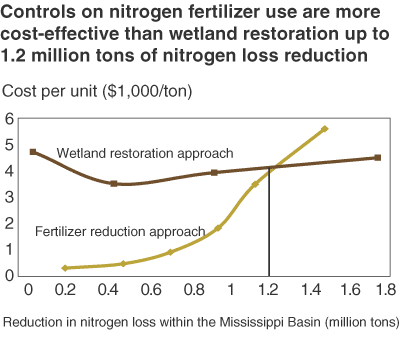Dead Zone in the Gulf: Addressing Agriculture's Contribution
- by Marc Ribaudo
- 11/1/2003
The Northern Gulf of Mexico’s hypoxic (oxygen-deficient) waters represent one of the Western Hemisphere’s largest “dead zones”—areas where lack of oxygen kills fish, crabs, and other marine life. The size of the zone varies but at its peak, it stretches along the inner continental shelf from the mouth of the Mississippi River westward to the upper Texas coast, covering about 7,000 square miles, an area as large as New Jersey. Long-term consequences to biodiversity, species abundance, and biomass in the Gulf are not yet known, but experience with other coastal dead zones has shown significant ecological deterioration and depleted fisheries.
Scientists believe that Gulf hypoxia is caused by nitrogen loads from the Mississippi River. Nitrogen fuels the rapid growth of large populations of algae and plankton. When they die and sink to the bottom, their decay robs the water of oxygen.
Because two-thirds of the nitrogen in the Mississippi River comes from use of fertilizer and manure on agricultural lands, reducing agricultural nitrogen is a major component of the strategy for controlling the hypoxic zone. Two basic approaches can be taken: (1) induce changes in the application and management of nitrogen fertilizer on farm fields, or (2) restore wetlands along rivers and streams to intercept and filter out the nitrogen before it reaches surface waters. Because the geographic scale of the problem is so large, any policy to reduce nitrogen from agriculture will affect commodity prices, and consequently farmers and consumers both inside and outside the basin.
An ERS analysis of the two approaches found farm-based controls on nitrogen fertilizer use to be more cost-effective than restoring wetlands when up to 1.2 million metric tons (26 percent) of basinwide nitrogen losses (nitrogen leaving the land and entering the water system) must be eliminated. Until that point, crop yields are little affected by the controls on nitrogen use. But when nitrogen losses must be cut by more than 1.2 million metric tons, a turnaround occurs and wetland restoration becomes the more cost-effective strategy. The reason for the turnaround is that when reduction in nitrogen use reaches a certain point, crop yields decline significantly, causing subsequent increases in prices of some agricultural products. The price increases also result in more intense production of the commodities outside the Mississippi Basin, increasing erosion and nutrient runoff in those regions. However, these calculations don’t include (because of insufficient data) other environmental benefits of wetlands not related to nitrogen reduction, such as increased habitat for wildlife. Inclusion of these benefits would cause the wetland option to become the more cost-effective approach at a lower level of nitrogen reduction.
This article is drawn from:
- Least-Cost Management of Nonpoint Source Pollution: Source Reduction Versus Interception Strategies for Controlling Nitrogen Loss in the Mississippi Basin. (2001). Ecological Economics. .



